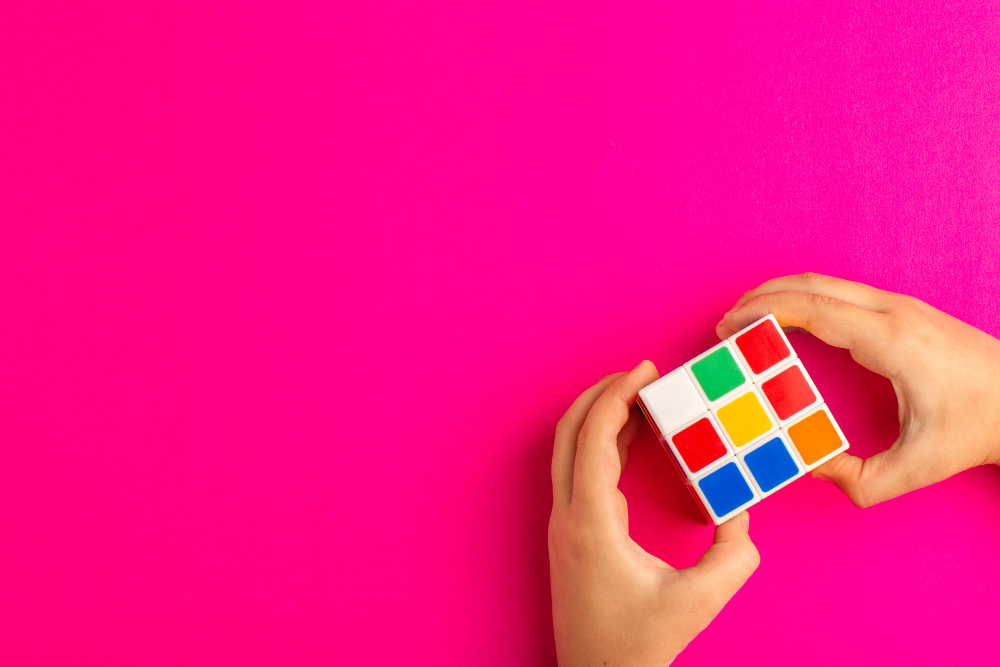Solving a Rubik’s Cube can seem like an impossible task for many, but with the right approach, anyone can master this fascinating puzzle. Whether you’re a beginner or someone who’s been struggling to find an effective method, this step-by-step guide will provide you with an easy trick to solve the cube. By the end of this article, you’ll be equipped with the knowledge and confidence to impress your friends and family with your newfound skill.
Introduction to the Rubik’s Cube
The Rubik’s Cube is a 3D combination puzzle invented in 1974 by Ernő Rubik. It consists of six faces, each covered by nine stickers, with each face displaying a different color. The objective is to twist and turn the cube to return it to its original state, where each face consists of a single color. This puzzle has fascinated and challenged millions of people around the world for decades. Solving the Rubik’s Cube requires not only a strategic approach but also a good understanding of its structure and movements.
Understanding the Basics
Before diving into the trick to solve the cube, it’s essential to understand its basic components and movements. The cube is made up of three types of pieces:
- Center Pieces: These are the fixed pieces in the middle of each face. They determine the color of each face and do not move. Each center piece is surrounded by edge and corner pieces and remains stationary relative to the others.
- Edge Pieces: These pieces have two colors and are located between the center pieces. There are 12 edge pieces on a standard Rubik’s Cube, and they can move around the cube as you twist and turn it.
- Corner Pieces: These pieces have three colors and are located at the corners of the cube. There are 8 corner pieces, and their correct placement and orientation are crucial to solving the cube.
The Trick to Solve Cube: Layer-by-Layer Method
The layer-by-layer method is one of the most popular and easiest ways to solve a Rubik’s Cube. It involves solving the cube layer by layer, starting from the bottom layer and working your way up. This method is beginner-friendly and highly effective. Here’s the step-by-step guide:
Step 1: Solving the White Cross
The first step is to create a white cross on the bottom layer. Here’s how you can do it:
- Find the White Edges: Locate the four white edge pieces. These are the pieces that have one white sticker and another color.
- Position the White Edges: Move these edges to form a cross on the white face. Ensure that the adjacent color of each white edge matches the center color of the corresponding face. This step requires a bit of maneuvering, but with practice, it becomes easier.
Detailed Process:
- Start by aligning one white edge piece with the white center piece.
- Rotate the cube to bring the other white edges into position, ensuring they align with both the white center and the corresponding side centers.
- Continue this process until all four white edge pieces are correctly positioned, forming a perfect cross.
Step 2: Solving the White Corners
After creating the white cross, the next step is to solve the white corners to complete the first layer:
- Find the White Corner Pieces: Locate the corner pieces that have white on them. These pieces will also have two other colors.
- Position the White Corners: Move these corners into place one by one. Use the algorithm R U R’ U’ to position them correctly. This algorithm involves rotating the right face and the upper face to position the corners.
Detailed Process:
- Identify a white corner piece and position it below the spot where it needs to go.
- Use the algorithm to bring the corner piece into place. If the corner is not oriented correctly, repeat the algorithm until it is.
- Repeat this process for all four white corners, ensuring each corner piece is correctly positioned and oriented.
Step 3: Solving the Middle Layer Edges
Once the first layer is complete, the next step is to solve the middle layer edges:
- Locate the Edge Pieces: Find the edge pieces that do not have yellow on them. These pieces need to be positioned in the middle layer.
- Position the Edges: Use the algorithms U R U’ R’ U’ F’ U F and U’ L’ U L U F U’ F’ to place the edges in their correct positions. These algorithms help move the edge pieces without disturbing the already solved first layer.
Detailed Process:
- Identify an edge piece that needs to be moved into the middle layer.
- Position this edge piece above the target location in the middle layer.
- Use the appropriate algorithm to move the edge piece into place. Ensure the adjacent colors match the center pieces.
- Repeat this process for all middle layer edges, ensuring they are all correctly positioned.
Step 4: Creating the Yellow Cross
With the first two layers complete, the next goal is to create a yellow cross on the top layer:
- Position the Yellow Edges: Use the algorithm F R U R’ U’ F’ to position the yellow edge pieces to form a cross. This algorithm helps position the yellow edges without disturbing the solved layers.
Detailed Process:
- Assess the current state of the yellow face. It might have no yellow edges, two yellow edges, or already be a cross.
- Apply the algorithm as needed to form the yellow cross. Depending on the initial state, you may need to repeat the algorithm multiple times.
Step 5: Solving the Yellow Corners
The final step involves positioning and orienting the yellow corners:
- Position the Corners: Use the algorithm U R U’ L’ U R’ U’ L to position the yellow corners correctly. This algorithm helps swap the corner pieces into their correct positions.
- Orient the Corners: Use the algorithm R’ D’ R D repeatedly until the corner is oriented correctly. Move to the next corner and repeat.
Detailed Process:
- Position the yellow corners in their correct spots using the first algorithm.
- Once all corners are in place, orient them correctly using the second algorithm. This may require several repetitions for each corner.
Advanced Tips and Tricks
Once you have mastered the basic layer-by-layer method, you can improve your speed and efficiency with these advanced tips:
- Finger Tricks: Learn finger tricks to turn the cube faster. Efficient finger movements can significantly reduce your solving time.
- Practice Algorithms: Familiarize yourself with additional algorithms for specific patterns. More advanced algorithms can help solve the cube more efficiently.
- Lookahead: Plan your moves in advance to reduce downtime between moves. Developing the skill of looking ahead allows you to execute algorithms smoothly without pausing to think.
Common Mistakes and How to Avoid Them
- Misalignment: Ensure that your layers are correctly aligned before performing algorithms. Misaligned layers can lead to incorrect moves and frustration.
- Incorrect Algorithms: Double-check the algorithms you use to avoid mistakes. Using the wrong algorithm or performing an algorithm incorrectly can scramble the cube further.
- Patience: Be patient and practice regularly to improve your skills. Solving the Rubik’s Cube requires practice, and becoming proficient takes time and dedication.
Benefits of Solving a Rubik’s Cube
Solving a Rubik’s Cube is not just a fun activity; it also has several benefits:
- Improves Memory: Memorizing algorithms and patterns enhances memory. Regular practice can help improve both short-term and long-term memory.
- Develops Problem-Solving Skills: The process of solving the cube helps improve problem-solving abilities. It requires critical thinking and strategic planning.
- Increases Patience and Concentration: Solving the cube requires patience and concentration, which can be beneficial in other areas of life. It helps develop focus and perseverance.
Conclusion
Solving a Rubik’s Cube may seem daunting at first, but with the right trick to solve cube, anyone can master it. By following this step-by-step guide and practicing regularly, you’ll be able to solve the cube in no time. Remember, the key to success is patience, practice, and perseverance. Happy cubing!




